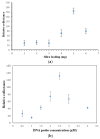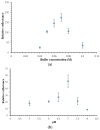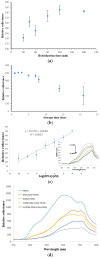Optical DNA Biosensor Based on Square-Planar Ethyl Piperidine Substituted Nickel(II) Salphen Complex for Dengue Virus Detection
- PMID: 29649118
- PMCID: PMC5948868
- DOI: 10.3390/s18041173
Optical DNA Biosensor Based on Square-Planar Ethyl Piperidine Substituted Nickel(II) Salphen Complex for Dengue Virus Detection
Abstract
A sensitive and selective optical DNA biosensor was developed for dengue virus detection based on novel square-planar piperidine side chain-functionalized N,N'-bis-4-(hydroxysalicylidene)-phenylenediamine-nickel(II), which was able to intercalate via nucleobase stacking within DNA and be functionalized as an optical DNA hybridization marker. 3-Aminopropyltriethoxysilane (APTS)-modified porous silica nanospheres (PSiNs), was synthesized with a facile mini-emulsion method to act as a high capacity DNA carrier matrix. The Schiff base salphen complexes-labelled probe to target nucleic acid on the PSiNs renders a colour change of the DNA biosensor to a yellow background colour, which could be quantified via a reflectance transduction method. The reflectometric DNA biosensor demonstrated a wide linear response range to target DNA over the concentration range of 1.0 × 10-16-1.0 × 10-10 M (R² = 0.9879) with an ultralow limit of detection (LOD) at 0.2 aM. The optical DNA biosensor response was stable and maintainable at 92.8% of its initial response for up to seven days of storage duration with a response time of 90 min. The reflectance DNA biosensor obtained promising recovery values of close to 100% for the detection of spiked synthetic dengue virus serotypes 2 (DENV-2) DNA concentration in non-invasive human samples, indicating the high accuracy of the proposed DNA analytical method for early diagnosis of all potential infectious diseases or pathological genotypes.
Keywords: dengue virus detection; nickel(II) salphen complex; optical DNA biosensor; porous silica nanospheres; reflectance measurement; synthetic DNA binder.
Conflict of interest statement
The authors declare no conflict of interest.
Figures








References
-
- Nascimento H.P.O., Oliveira M.D.L., Melo C.P.D., Silva G.J.L., Cordeiro M.T., Andrade C.A.S. An impedimetric biosensor for detection of dengue serotype at picomolar concentration based on gold nanoparticle-polyaniline hybrid composites. Colloids Surf. B Biointerfaces. 2011;86:414–419. doi: 10.1016/j.colsurfb.2011.04.028. - DOI - PubMed
-
- Zhang G.J., Zhang L., Huang M.J., Luo Z.H.H., Tay G.K.I., Lim E.A., Kang T.G., Chen Y. Silicon nanowire biosensor for highly sensitive and rapid detection of Dengue virus. Sens. Actuators B Chem. 2010;146:138–144. doi: 10.1016/j.snb.2010.02.021. - DOI
MeSH terms
Substances
LinkOut - more resources
Full Text Sources
Other Literature Sources
Molecular Biology Databases
Miscellaneous

